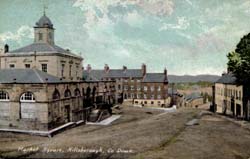|
The Setons of
Barnes
The second
Sir John Seton of Barnes succeeded to his father
when he came of age:
a gallant man; likewise a gentleman of the privy chamber
to King Charles the First. He acquired, from Sir Robert
Gordon of Lochinvar, land in Ireland worth five hundred
pounds Sterling a year. He also acquired the castle of
Hailes and of Crichton, albeit it briefly, as well as
other lands in Amisfield. The said Sir John was
imprisoned, and fined in a considerable sum of money, by
the then rebels in Scotland, for being with the Marquess
of Montrose, King Charles the First his general, by an
ample commission, against the Scots rebels, in the year
1646.
He married to his first lady, Ogilvy, daughter to the
laird of Poury, Ogilvy ; by her, he had one son and
three daughters. His
son, called Alexander, married in Ireland, a daughter of
a noble
Irish family of Ophuall (O'Ferrall): imprisoned for
being accused of assisting the Ferralls, he was
eventually brought home to Edinburgh and imprisoned in
the Tolbooth and dyed not long after his release without
succession. His eldest daughter, Isobell, married the
laird of Barfoord ; the second daughter, Margaret,
married to the tutor of Duffus, in Murray ; his third
daughter, Lilias, married Sir James Ramsay of Benhame,
in the
Mairns.
To his second marriage, Sir John Seton 2nd of Barnes married the dowager of Killsyth, daughter to lord Fleming, by whom he had no
succession.
To his third wife, he married the only daughter of Sir
John Home
of Northberwick, by whom he had two sons, George and
Charles, and one daughter, Jean : Charles dyed a young
man, shortly after his father; his daughter Jean was
married to John Hay of Aberlady. His eldest son,
George Seton, succeeded and was possessor of the lands
of Barnes, Hailes, others in Amisfield and the Irish estate of Moneylagan.
Although
principally the family in Ireland remained around Moneylagan, they were
displaced by Sir Arthur Forbes, Viscount Granard and
settled in various other locations in Ireland as a
result, such as in Counties Tyrone, Antrim and Down.
One
branch of the Seaton family in
Ireland is later listed as being either from a place called, “Dranity” or Tullahoago.
These are both town-land names in
County
Tyrone and refer to Tullahoge, County
Tyrone. Dranity was a small farm-land name
that no longer exists.
 |
Market
Square, 19th cen. Hillsborough, Co. Down,
Ireland |
| | |
What is
certain is that there are a number of Seaton families
that were established in the Dromore region of
County Down and also
in Donaghmore and Dungannon, County Tyrone, Ireland,
such as:
Robert
Seaton who married Jane McCabe of Co. Down, Ireland and had
three boys but sadly died enroute to America in 1806;
Jeremiah Seaton married Nancy Neal and had a large
family; William Seaton, who never married, originally
went to America and made a small fortune before
returning to Ireland and purchased a farm near
Stranorlar, Country Donegal, Ireland, near his brother
Jeremiah who had also settled in Co. Donegal.
Jeremiah's children settled into various parts of
America throughout the 1800's and his son Samuel settled on Presque Isle for sometime.
Thomas
Seaton (the 2nd), was born circa 1727 and maintained
various family business interests and Flax farming
around Tullahoge (Tellahoago, also called Dranity), a
hamlet in the parish of Desertcreat, in the Upper
Dungannon Barony, near Cookstown Co. Tyrone. Of Thomas
(the 2nd) was also know very little, though we know from
Nova Scotian family notes of his son James that he had
three children: Mary, Thomas (the 3rd) and James. While
there are precious few records remaining for this period
in Ireland, his sons are listed on the Freeholder's List
for 1796 in the Barony of Dungannon along with Ezekiel who is likewise listed on the same
Freeholder's list. Ezekiel SEATON emigrated to America
in 1799 and lived a number of years in Philadelphia,
where he conducted a hotel. He had a daughter Elizabeth
who married John Graham of Co. Down, Ireland and who
immigrated to America and met and married Ezekiel's
daughter there.
Thomas
Seaton (2nd) died in 1811, aged 84 years and was buried
in the Presbyterian Graveyard in the Town or Townland of
Glebe (Derryloran also called Donaghenry), in the Civil
Parish of Donaghenry, Donaghenry Old, County Tyrone,
Ulster, Ireland. Of his three children: 1st a daughter
Mary who died early in life at 19 years of age; 2nd his
eldest son and heir also called Thomas (3rd) who died
shortly after his father but leaving issue; and 3rd a son James Seaton
(later spelt as "Seeton" in Nova Scotia) who
married Martha Crawford of County Tyrone and who emigrated to Nova Scotia and from whom descends the Seeton's of Nova Scotia. (Note: Thomas (the 3rd) may
also have had other children who remained in Ireland who
also utilized the spelling of Seeton as their
family-name - noticed for George Seeton who married Mary
Grimble (or Coulter) and who immigrated to America in the mid-to-late
1800's and his brother John Seeton who ended up in
Australia circa the same time frame).
The family
are buried as per the Headstone inscription
from Dungannon which is as follows:
Here lieth the body of Mary Seaton who departed this life May 9th 1781 aged
19 years. Also Thomas Seaton who departed this life 14th May 1811 aged 84,
also his son Thomas who departed this life 19th June 1818 aged 44 years.
Also Jane Seaton also departed this life 18th Novr. 1828 aged 103 years.
>
Next
page
|


